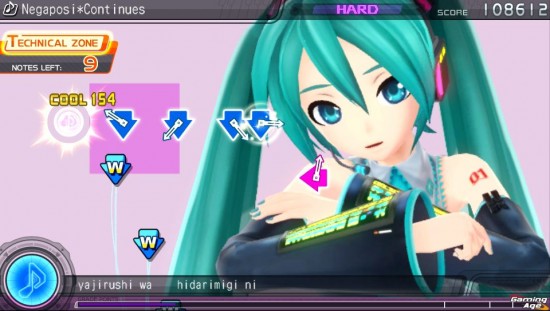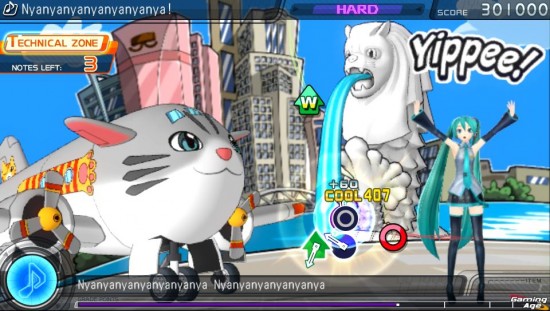Also On: PS3
Publisher: Sega
Developer: Sega
Medium: Digital
Players: 1
Online: No
ESRB: T
Does Hatsune Miku: Project Diva f have the most impressive graphics ever for a music game? While my knowledge of the genre is (very) far from encyclopedic, I’d be willing to wager that it’s certainly up there. After all, most — your Rock Bands, your Guitar Heroes and whatnot — simply feature notes travelling along a line on the screen, so it’s not as if they’re that graphically dazzling. Even games that broke the usual mold a little, like Theatrhythm Final Fantasy or Michael Jackson: The Experience, were nothing special. So when you have a game like Hatsune Miku, that basically looks like a cross between an animated concert and a karaoke video, it naturally stands out.
Two things about that:
First, it would be kind of a big deal if Hatsune Miku f didn’t have better-than-usual graphics. I’ll confess that I don’t fully understand the whole “vocaloid” thing, but near as I can tell (thanks to Wikipedia, naturally) the game’s titular character and friends are the anime-ized versions of a singing synthesizer program, and she’s so popular in Japan that she’s performed live concerts via hologram. As far as I’m concerned, anything that’s had so much real-world impact and been shown to so many people had darn well better look nice. In other words, it seems to me that being nice-looking is what should be expected in this case, not some added bonus.
The other thing is…the more I’ve played of the game, the more I’ve understood why music and rhythm games don’t usually make things visually complex: it can make it awfully hard to follow what’s going on. It’s hard to screw up following notes when they move along predetermined lines. In Hatsune Miku’s case, not only do the notes appear all over the screen moving in different directions, they’re also competing with the on-screen action for your attention. At times, this can make things feel a little too frantic. Some of that, of course, is by design, but at others, it seems like it’s just poorly planned out.
That said, this busy-ness doesn’t happen often enough to rate as anything more than a minor — albeit persistent — annoyance. In fact, I have to say that one of the upsides of it is that the game never feels stale. The layer of dust coating my Guitar Hero band set is a testament to the fact that, invariably, every time I played one of those rhythm games I’d lose interest as they all started feeling kind of same-y. Here, by contrast, each song has its own distinctive style, which makes it feel like you’re doing something new each time, rather than rehashing the same thing over and over again.
Of course, the real star of Hatsune Miku: Project Diva f is — as it should be — the music. Even if you’re like me, and you’ve never listened to a note of J-Pop before in your life, you’re liable to find the songs here shockingly catchy. You may not always know where the notes on screen are going, but the music itself is so well put together that you’re likely to find yourself grooving along (and, consequently, be forced to retry each song multiple times as you try to ignore the catchiness in favor of getting a little further along in the game).
You may, of course, be a little skeptical of the whole thing. I mean, a rhythm game based on the music of a singing synthesizer company’s (wildly popular in Japan) humanoid mascot? If you were looking for the definition of “niche game”, at the very least this would be a supporting example in the dictionary. But it’s also very, very fun. No matter how odd it may seem, as soon as the opening notes of the very first song (“Ievan Polkka”) kick in, you’re probably going to get hooked.



